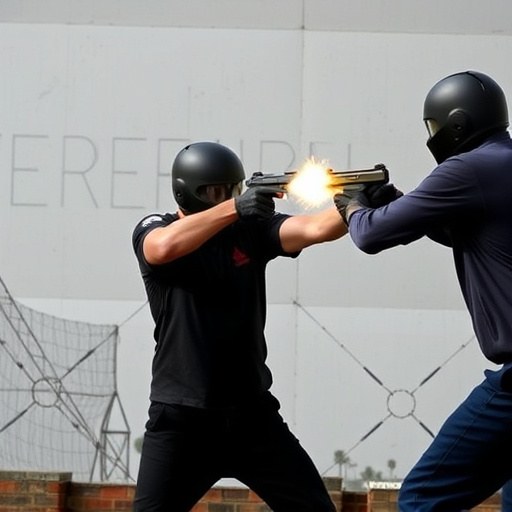Stun Gun Impact: Understanding Muscle Incapacitation Duration
Stun guns disrupt nerve signals controlling muscle function, leading to brief (seconds to minutes) i…….
Stun guns disrupt nerve signals controlling muscle function, leading to brief (seconds to minutes) involuntary contractions and subsequent relaxation that paralyze muscles and render targets immobile. The duration of muscle incapacitation varies based on stun gun power output, target body mass, affected nerve pathways, individual health, fitness level, targeted body area, stun intensity, and exposure duration. Recovery times also vary significantly, with higher voltage levels and extended exposure leading to more severe muscle incapacitation and delayed recovery. Individuals with neurological conditions or certain medications may experience further delays due to disruptions in nervous system functions.
Stun guns, popular for personal defense, deliver powerful electric shocks that temporarily incapacitate targets. Understanding the duration of muscle incapacitation caused by these devices is crucial for safety and legal considerations. This article explores the effects of stun guns on the nervous system, delving into the science behind the shock’s impact. We analyze factors influencing recovery time and provide insights into the potential outcomes, offering a comprehensive guide to the stun gun effects on the nervous system.
- Stun Guns and Their Impact on the Nervous System
- Duration of Muscle Incapacitation: What Science Says
- Factors Influencing Recovery Time After Stun Gun Exposure
Stun Guns and Their Impact on the Nervous System

Stun guns, also known as tactical electric weapons, operate by delivering a powerful electric shock to temporarily incapacitate a target. Their primary mechanism of action lies in their ability to disrupt the normal functioning of the nervous system. When activated, stun guns emit a high-voltage, low-amperage electrical pulse that interferes with nerve signals, specifically those responsible for muscle control and coordination. This interference leads to involuntary muscle contractions and subsequent relaxation, resulting in temporary paralysis or incapacitation.
The impact of stun guns on the nervous system is rapid and intense. The electric shock disrupts the electrical impulses transmitted through nerves, causing them to fire erratically or not at all. This disruption can last for a brief period, typically ranging from several seconds to a minute or so, depending on various factors such as the stun gun’s power output, the target’s body mass, and the specific nerve pathways affected. During this time, the individual becomes temporarily stunned, with their muscles unable to function properly, making them vulnerable and immobile.
Duration of Muscle Incapacitation: What Science Says

The duration of muscle incapacitation caused by stun guns is a topic of interest for both law enforcement and individuals seeking self-defense options. Scientific research provides insights into how these devices affect the nervous system, leading to temporary paralysis. Studies suggest that the impact can last from several seconds up to a minute or more, depending on various factors such as the stun gun’s power output, the location of contact, and the individual’s physical condition.
The stun gun effects on the nervous system are designed to disrupt muscle control by delivering an electric current through the body. This interference temporarily overrides the signals between the brain and muscles, leading to a loss of motor function in the affected areas. While the initial shock may wear off quickly, the subsequent muscular incapacitation can provide valuable time for escape or self-defense strategies.
Factors Influencing Recovery Time After Stun Gun Exposure

The recovery time after exposure to a stun gun can vary greatly due to several factors. One of the primary influences is the individual’s overall health and fitness level; generally, those in better physical condition may experience quicker recovery times. The specific area targeted by the stun gun also plays a significant role. Nerve endings in certain regions, such as the legs or arms, can take longer to regain full function compared to areas like the torso.
Furthermore, the intensity of the stun and its duration directly impact recovery. Higher voltage levels and extended exposure can lead to more severe muscle incapacitation, resulting in a lengthier recovery period. The Stun Gun Effects on Nervous System also contribute; individuals with pre-existing neurological conditions or those taking specific medications may experience delayed recovery due to the stun’s disruption of nervous system functions.
Stun guns, while designed for self-defense, can have significant effects on the nervous system, leading to muscle incapacitation. The duration of this effect varies based on factors such as the stun gun’s output and the individual’s physical condition. Scientific studies indicate that recovery times typically range from a few minutes to an hour, with certain variables prolonging or reducing this period. Understanding these effects and their influences is crucial for both users and law enforcement, emphasizing the importance of responsible usage and prompt medical attention when needed.


